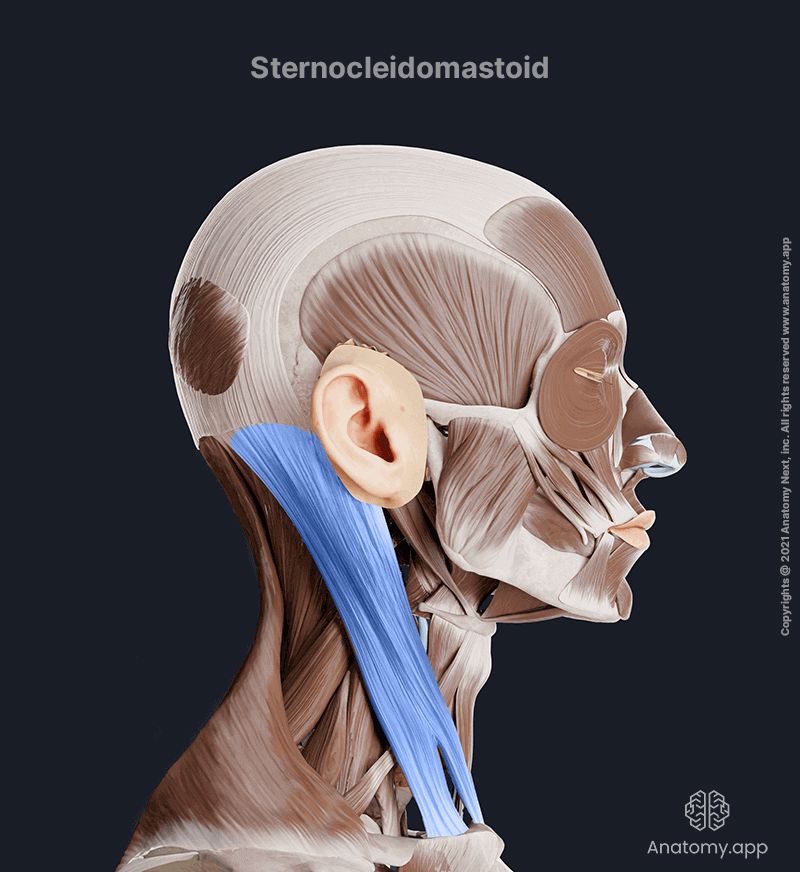- Anatomical terminology
- Skeletal system
- Joints
- Muscles
- Head muscles
-
Neck muscles
- Superficial neck muscles
- Scalene muscles
- Suprahyoid muscles
- Infrahyoid muscles
- Prevertebral muscles
- Suboccipital muscles
- Muscles of upper limb
- Thoracic muscles
- Muscles of back
- Muscles of lower limb
- Heart
- Blood vessels
- Lymphatic system
- Nervous system
- Respiratory system
- Digestive system
- Urinary system
- Female reproductive system
- Male reproductive system
- Endocrine glands
- Eye
- Ear
Sternocleidomastoid
The sternocleidomastoid (Latin: musculus sternocleidomastoideus) is a long paired muscle of the neck. Together with the platysma, it is classified as the superficial neck muscle. The sternocleidomastoid lies on each side of the neck, extending from the sternum and clavicle to the base of the skull. It also belongs to the anterior neck muscles.
| Sternocleidomastoid | |
| Origin | Manubrium of sternum, sternal end of clavicle |
| Insertion | Mastoid process of temporal bone, superior nuchal line of occipital bone |
| Action | Unilateral contractions - neck ipsilateral flexion, elevation of chin, head contralateral rotation Bilateral contractions - extension of upper vertebral joints, extension of neck and head, elevation of head, elevation of sternum and clavicle, expansion of thoracic cavity |
| Innervation | Accessory nerve (CN XI), branches of cervical plexus (C2 - C3) |
| Blood supply | Sternocleidomastoid branches of occipital and superior thyroid arteries |
Origin
The sternocleidomastoid muscle originates from the manubrium of the sternum and sternal end of the clavicle.

Insertion
The fibers of the sternocleidomastoid insert on the lateral aspects of the mastoid process of the temporal bone and superior nuchal line of the occipital bone.
Action
The main action provided by the sternocleidomastoid muscle is the lateral flexion of the head. Unilateral contractions of the sternocleidomastoid provide the neck ipsilateral flexion, resulting in elevation of the chin and rotation of the head to the opposite side (head contralateral rotation).
In contrast, bilateral contractions of the muscle extend the upper vertebral joints, thus extending the neck and elevating and extending the head. The sternocleidomastoid is also known as one of the accessory muscles of inspiration. Bilateral contractions of the muscle help elevate the sternum and clavicle, expanding the thoracic cavity.
Innervation
The nerve supply to the sternocleidomastoid is provided by the accessory nerve (CN XI) and nerves arising from the cervical plexus (C2 - C3).
Blood supply
The arterial blood to the sternocleidomastoid muscle is mainly supplied by the branches of the external carotid artery. These branches include the sternocleidomastoid arteries of the superior thyroid and occipital arteries.
The venous drainage of the sternocleidomastoid is provided by the sternocleidomastoid vein. It further drains into the internal jugular or superior thyroid vein.